Attached files
| file | filename |
|---|---|
| 8-K - FORM 8-K - REGIONS FINANCIAL CORP | d8k.htm |
 Exhibit 99.1
*
*
* |
 Forward-Looking
Statements 1
This presentation may include forward-looking statements which reflect Regions’ current views
with respect to future events and financial performance. The Private Securities Litigation Reform Act of 1995
(“the Act”) provides a “safe harbor” for forward-looking statements which are
identified as such and are accompanied by the identification of important factors that could cause actual results to differ
materially from the forward-looking statements. For these statements, we, together with our
subsidiaries, claim the protection afforded by the safe harbor in the Act. Forward-looking statements are not
based on historical information, but rather are related to future operations, strategies, financial
results or other developments. Forward-looking statements are based on management’s expectations as well
as certain assumptions and estimates made by, and information available to, management at the time the
statements are made. Those statements are based on general assumptions and are subject to
various risks, uncertainties and other factors that may cause actual results to differ materially from
the views, beliefs and projections expressed in such statements. These risks, uncertainties and other
factors include, but are not limited to, those described below:
›
The Dodd-Frank Wall Street Reform and Consumer Protection Act became law on July 21, 2010, and a
number of legislative, regulatory and tax proposals remain pending. Additionally, the U.S. Treasury
and federal banking regulators continue to implement, but are also beginning to wind down, a number of
programs to address capital and liquidity in the banking system. All of the foregoing may have
significant effects on Regions and the financial services industry, the exact nature and extent
of which cannot be determined at this time.
›
The impact of compensation and other restrictions imposed under the Troubled Asset Relief Program
(“TARP”) until Regions repays the outstanding preferred stock and warrant issued under the TARP,
including restrictions on Regions’ ability to attract and retain talented executives and
associates.
›
Possible additional loan losses, impairment of goodwill and other intangibles, and adjustment of
valuation allowances on deferred tax assets and the impact on earnings and capital.
›
Possible changes in interest rates may increase funding costs and reduce earning asset yields, thus
reducing margins.
›
Possible changes in general economic and business conditions in the United States in general and in
the communities Regions serves in particular, including any prolonging or worsening of the current
unfavorable economic conditions including unemployment levels.
›
Possible changes in the creditworthiness of customers and the possible impairment of the
collectability of loans.
›
Possible changes in trade, monetary and fiscal policies, laws and regulations and other activities of
governments, agencies, and similar organizations, including changes in accounting standards, may
have an adverse effect on business.
›
The current stresses in the financial and real estate markets, including possible continued
deterioration in property values.
›
Regions' ability to manage fluctuations in the value of assets and liabilities and off-balance
sheet exposure so as to maintain sufficient capital and liquidity to support Regions' business.
›
Regions' ability to achieve the earnings expectations related to businesses that have been acquired or
that may be acquired in the future.
›
Regions' ability to expand into new markets and to maintain profit margins in the face of competitive
pressures.
›
Regions' ability to develop competitive new products and services in a timely manner and the
acceptance of such products and services by Regions' customers and potential customers.
›
Regions' ability to keep pace with technological changes.
›
Regions' ability to effectively manage credit risk, interest rate risk, market risk, operational risk,
legal risk, liquidity risk, and regulatory and compliance risk.
›
Regions’ ability to ensure adequate capitalization which is impacted by inherent uncertainties in
forecasting credit losses.
›
The cost and other effects of material contingencies, including litigation contingencies, and any
adverse judicial, administrative or arbitral rulings or proceedings.
›
The effects of increased competition from both banks and non-banks.
›
The effects of geopolitical instability and risks such as terrorist attacks.
›
Possible changes in consumer and business spending and saving habits could affect Regions' ability to
increase assets and to attract deposits.
›
The effects of weather and natural disasters such as floods, droughts and hurricanes, and the effects
of the Gulf of Mexico oil spill.
›
Regions’ ability to maintain favorable ratings from rating agencies.
›
Potential dilution of holders of shares of Regions’ common stock resulting from the U.S.
Treasury’s investment in TARP.
›
Possible changes in the speed of loan prepayments by Regions’ customers and loan origination or
sales volumes.
›
The effects of problems encountered by larger or similar financial institutions that adversely affect
Regions or the banking industry generally.
›
Regions’ ability to receive dividends from its subsidiaries.
›
The effects of the failure of any component of Regions’ business infrastructure which is provided
by a third party.
›
The effects of any damage to Regions’ reputation resulting from developments related to any of
the items identified above. The foregoing list of factors is not exhaustive; for discussion of these and other risks that may
cause actual results to differ from expectations, please look under the caption “Risk Factors” in Regions’ Annual
Report on Form 10-K for the year ended December 31, 2009 and Forms 10-Q for the quarters ended
June 30, 2010 and March 31, 2010, as on file with the Securities and Exchange Commission. The words "believe," "expect," "anticipate," "project," and
similar expressions often signify forward-looking statements. You should not place undue reliance on any forward-looking statements, which speak
only as of the date made. Regions assumes no obligation to update or revise any forward-looking
statements that are made from time to time. |
 Business Overview
Grayson Hall
*
*
*
* |
 Agenda
and Introductions Grayson Hall
Business Overview
David Turner
Financial Review
Bill Wells
Credit Quality
BREAK
John Owen
Consumer Services
John Asbury
Business Services
John Carson
Morgan Keegan
Regional Presidents Panel
Regional Updates
LUNCH
Grayson Hall/David Turner
Break Out Session
John Owen/John Carson/John Asbury
Break Out Session
Regional Presidents/Bill Wells
Break Out Session
2 |
 Overview
›
Environmental factors impacting industry
›
Key issues impacting Regions
›
Strategic priorities driving results
3 |
 Environmental Factors Impacting Industry
›
Economy
›
Low consumer and business confidence
›
High unemployment forecasted to continue
›
Home price stabilization is mixed
›
Financial Reform
›
Impacts consumers, industry and economy
›
Implementation process just beginning
›
Gulf Oil Spill
›
Monitoring crisis closely
›
Following a proven disaster recovery plan
4 |
 Key
Issues Impacting Regions ›
Morgan Keegan Regulatory Matters
›
Capital Purchase Program Repayment
5 |
 Strategic Priorities Achieving Results
›
Keep Business Focused on the Customer
›
Strong deposit base and more active customers
›
Customer loyalty well above industry norms
›
Protect Our Future
›
Smarter risk management
›
Strong capital and liquidity positions
›
Restore Financial Performance
›
Improving net interest margin
›
Rigorous expense control
›
Execute with Excellence
›
Clear goals and accountability
›
Right plans, right people and laser sharp focus
6 |
 Financial Update
David Turner
*
*
*
* |
 Earnings: Improving trends in PPNR and LLP
Q2
Q3
Q4
Q1
Q2
($ in millions)
2009
2009
2009
2010
2010
Stable and Improving PPNR
Net Interest Income
$ 831
$ 845
$ 850
$ 831
$ 856
Core Non-Interest Income*
761
764
744
734
756
Core Revenue*
1,592
1,609
1,593
1,565
1,612
Net Interest Margin
2.62%
2.73%
2.72%
2.77%
2.87%
Core Non-Interest Expense*
1,099
1,199
1,207
1,168
1,126
Core Pre-Tax Pre-Provision Net Revenue*
493
409
386
397
486
Improving Credit / LLP Trends
Loan Loss Provision
912
1,025
1,179
770
651
Net Charge Offs / Avg Loans
2.06%
2.86%
2.99%
3.16%
2.99%
Improving Results
Core EPS*
$ (0.35)
$ (0.35)
$ (0.46)
$ (0.21)
$ (0.11)
*Non-GAAP, refer to Appendix for non-GAAP reconciliation
2 |
 Margin: Declining deposit costs drive net
interest margin improvement
Loan
Yields
Net
Interest
Margin
Deposit
Costs
3 |
 Credit: Net charge offs stabilized
and NPLs
declined
ALLL / NPLs
0.87x
0.82x
0.89x
0.86x
0.92x
4 |
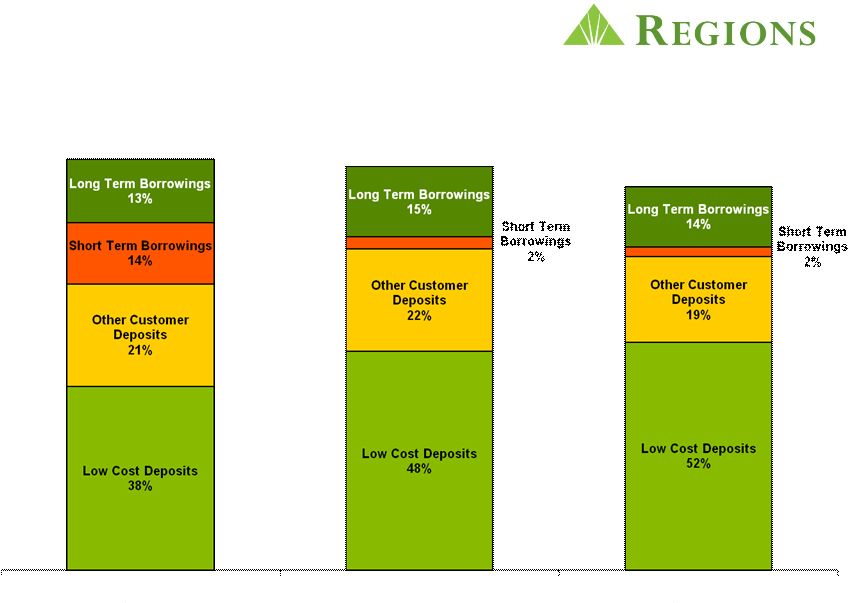 Total Wholesale funding
$33.6B
$22.8B
$17.9B
% of Total Funding
27%
18%
15%
December 31, 2008
December 31, 2009
June 30, 2010
Improved Funding Mix
5 |
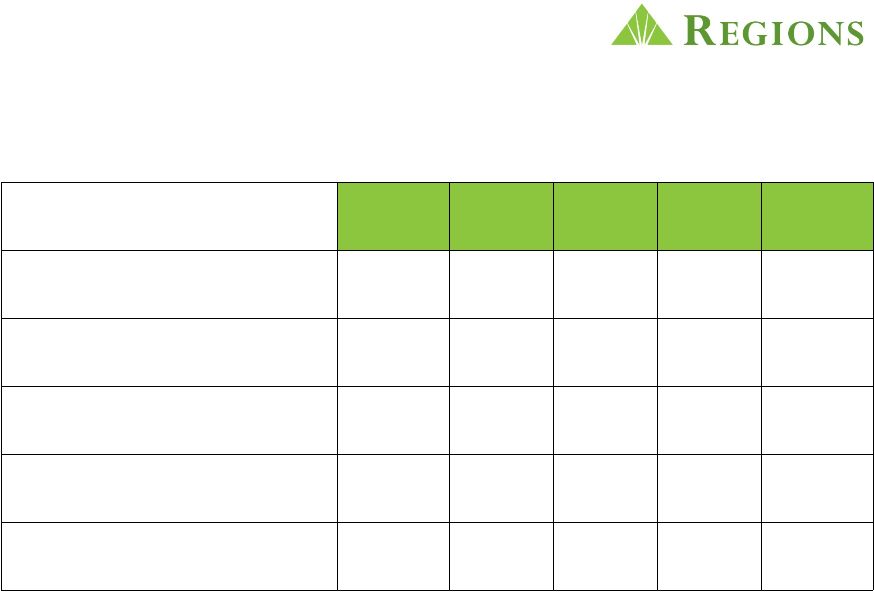 Capital Update
2Q 2009
3Q 2009
4Q 2009
1Q 2010
2Q 2010*
Tier 1 Common Ratio
8.1%
7.9%
7.1%
7.1%
7.7%
Tangible Common Equity Ratio
6.6%
6.6%
6.0%
6.1%
6.3%
Tier 1 Capital Ratio
12.2%
12.2%
11.5%
11.7%
12.0%
Total Capital Ratio
16.2%
16.3%
15.8%
15.8%
15.9%
Tangible Book Value per Share
$7.58
$7.40
$6.89
$6.71
$6.45
* Estimate
6 |
 Capital Update: Capital vs. Peers
Peers include BAC, BBT, CMA, FITB, KEY, MI, MTB, PNC, STI, USB, WFC
7 |
 We Are
Lending and Remain Focused on Meeting Our Customers’
Needs
›
$92 billion in new / renewed loan commitments to
more than over 244k customers in the last 18 months
›
Regions Customer Assistance Program
›
Assisted more than 30,000 homeowners and
restructured $2.3 billion in mortgages
›
US Treasury’s Home Affordable Modification Program
›
Investing in new products and services for our
customers
8 |
 We
Have Strengthened Our Core Franchise Through Productivity and Efficiency
Initiatives ($ in millions)
2007
2008
2009
Branches
1,965
1,900
1,895
›
Further reduced branch
count by 120 in 1Q10
Employees
33,161
30,784
28,509
›
Headcount declined 4,652
or 14%
Core
Expenses*
$3,991
$3,936
$3,704
›
Total core expenses
declined $287MM or 7%
* Excludes FDIC expense, other real estate expense, legal and professional fees,
credit investigations, credit support expense, unfunded commitments, MSR
impairment, loss on early extinguishment of debt, branch consolidation costs,
VISA settlement and securities impairment
9 |
 ›
Core profitability focus
›
Leaner, more efficient franchise
›
Single platform
›
Reduced headcount
›
Consolidated branch network
›
Invest where profitability hurdles are achieved
›
Effective expense management
›
Solid position in diversified footprint
›
Great branch coverage
›
Broad product offerings
›
Strong brand and customer loyalty
›
Solid capital and liquidity
Focused on Profitability and Well Positioned
For the Long Run
10 |
 Credit Quality
William C. Wells II
*
*
*
* |
 Credit
Process Improvements Through the Cycle
›
Complete cover-to-cover review of credit policy
›
Strengthened credit authorities
›
Refined portfolio concentration limits
›
Enforced consistent and sound underwriting
standards
›
Lowered the risk profile of the loan portfolio
›
Focused on resolution of problem assets
›
Actively work with customers in need of
financial support
2 |
 Total
Loan Portfolio $85.9B
Investor Real Estate $18.9B
Commercial
and Industrial
$21.1B / 25%
Owner
Occupied
Real Estate
$12.5B / 15%
Investor
Real Estate
$18.9B
22%
Residential
First Mortgage
$15.6B / 18%
Indirect
$1.9B / 2%
Direct and
Other
$1.1B
1%
Home
Equity
$14.8B
17%
Land
$2.3B / 12%
Single Family
$1.6B / 9%
Condo -
$0.4B / 2%
Hotel -
$1.0B / 5%
Industrial -
$1.3B / 7%
Office
$2.8B / 15%
Retail
$3.6B / 19%
Multi Family
$4.8B / 25%
Other -
$1.1B / 6%
3 |
 Investor Real Estate Portfolio is Diversified
22% of Total Portfolio
Other*
$3.1B / 17%
FL
$4.4B / 23%
TX
$2.1B / 11%
GA
$1.9B / 10%
TN
$1.7B / 9%
AL
$1.6B / 9%
NC
$1.1B / 6%
LA -
$0.9B / 4%
MO -
$0.6B / 3%
SC -
$0.6B / 3%
AR -
$0.5B / 3%
Loan Size
Geography
* Other includes states with exposure of less than 2%
0
5,000
10,000
15,000
20,000
25,000
30,000
<$1MM
$1MM-
10MM
$10MM-
25MM
$25MM+
$806 Thousand Average Loan Balance
20,540
2,551
341
74
# of Loans
VA -
$0.4B / 2%
4 |
 Credit
Metrics are Stabilizing but the Portfolio Remains Stressed
›
Non-performing asset migration has continued
to moderate
›
Charge-offs have moderated
›
Another solid quarter in disposing of problem assets
›
Allowance for Loan and Lease Losses remained level
5 |
 Net
Charge-offs Moderating (in millions)
2Q09
3Q09
4Q09
1Q10
2Q10
Net Charge-offs
IRE Valuation Losses
$129
$191
$215
$198
$142
Investor Real Estate (IRE)
39
45
55
59
74
Commercial
99
136
107
128
117
Consumer Real Estate
164
150
168
177
167
Other Consumer
24
30
32
28
19
Net Charge-offs excluding
charge-offs from Sales /
Transfers to HFS
455
552
577
590
519
Sales/Transfer to HFS
36
128
115
110
132
Total Net Charge-offs
$491
$680
$692
$700
$651
6 |
 ($500)
$0
$500
$1,000
$1,500
$2,000
2Q09
3Q09
4Q09
1Q10
2Q10
0%
5%
10%
15%
20%
25%
30%
35%
40%
Gross Additions
Dispositions
Net NPA Change
Charge-Offs
Discount on Disposition Activity
NPA Migration Moderates
1,758
1,667
1,404
1,306
281
554
643
689
1,122
662
376
221
(297)
887
779
491
680
692
700
651
Dispositions
includes
OREO
Sales,
Problem
Loan
and
HFS
Sales
and
Transfers
to
HFS
7 |
 Provision Stabilized and Matched Charge Offs
491
680
692
700
651
345
487
70
421
$0
$200
$400
$600
$800
$1,000
$1,200
2Q09
3Q09
4Q09
1Q10
2Q10
Net Charge Offs
Provision over Net Charge Offs
$912
$1,025
$1,179
$770
$651
Loan Loss Provision
8 |
 Total TDRs -
$1.6B*
$0
$400
$800
$1,200
$1,600
$2,000
2Q09
3Q09
4Q09
1Q10
2Q10
Accruing
Non-Accruing
$ millions
›
Modifications are a result of our proactive outreach efforts
›
Any concession to a customer experiencing financial difficulty
creates a TDR
Residential Mortgage -
65%
Home Equity -
20%
Other Consumer -
4%
Commercial -11%
Consumer TDRs -
$1.4B*
95% are accruing interest
*Includes accruing loans, non-accruing loans and loans 90+ days past due
9 |
 Customer Assistance Program
›
To ensure that customers who encounter financial
difficulty know there is help available and we want
to work with them
Achievements
›
Helped over 30,000 people stay in their homes
›
Proactively made over 400,000 outreach calls
›
Recidivism rate is 20%
›
Foreclosure rate is less than half the national average
10 |
 Gulf
Oil Spill Update ›
Closely monitoring loans across the Gulf and
reaching out to customers
›
The number of customers affected remains a small
subset of the overall portfolio
›
Customer Assistance Program (CAP) continues to
assist customers in need of financial support
11 |
 Second Quarter Summary
›
Non-performing Asset Migration has continued
to moderate
›
Charge-offs moderated
›
Provision expense moderated
›
Allowance for Loan and Lease Losses
remained level
›
Investor Real Estate reduced from $26.1B
at 12/31/07 to $18.9B at 6/30/2010
›
Construction loans down $3.8B from $11.8B
at 12/31/07
12 |
 Consumer Services
John Owen
*
*
*
* |
 Consumer Services Overview
Diversified Offerings
Multi Channel Delivery
Deposits
Mortgage
Consumer
Lending
Insurance
Credit/Debit
Cards
Focused on the Customer
2 |
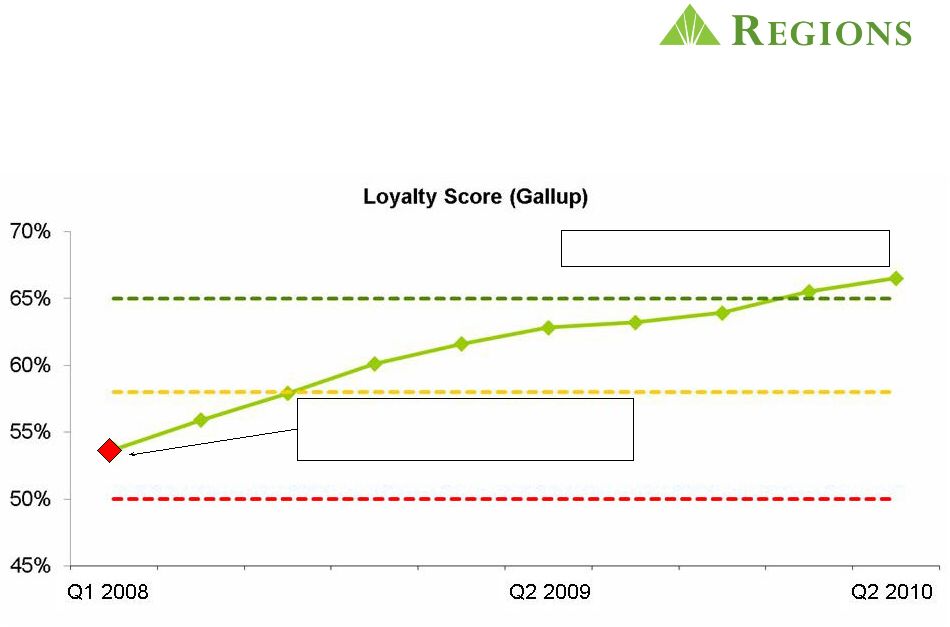 Customer Loyalty is the Foundation for Growth
Regions –
Q1 2008
Ranked in Middle of the Pack
Regions Ranked in Top 10%
Excellent -
Gallup 90th percentile
Average -
Gallup 50th percentile
Good -
Gallup 75th percentile
3 |
 Branch Customer Experience At An All-Time High
Excellent -
Gallup 90th percentile
Average -
Gallup 50th percentile
Regions Reached Top 20%
Regions –
Q1 2008
Ranked in Middle of the Pack
Good -
Gallup 75th percentile
4 |
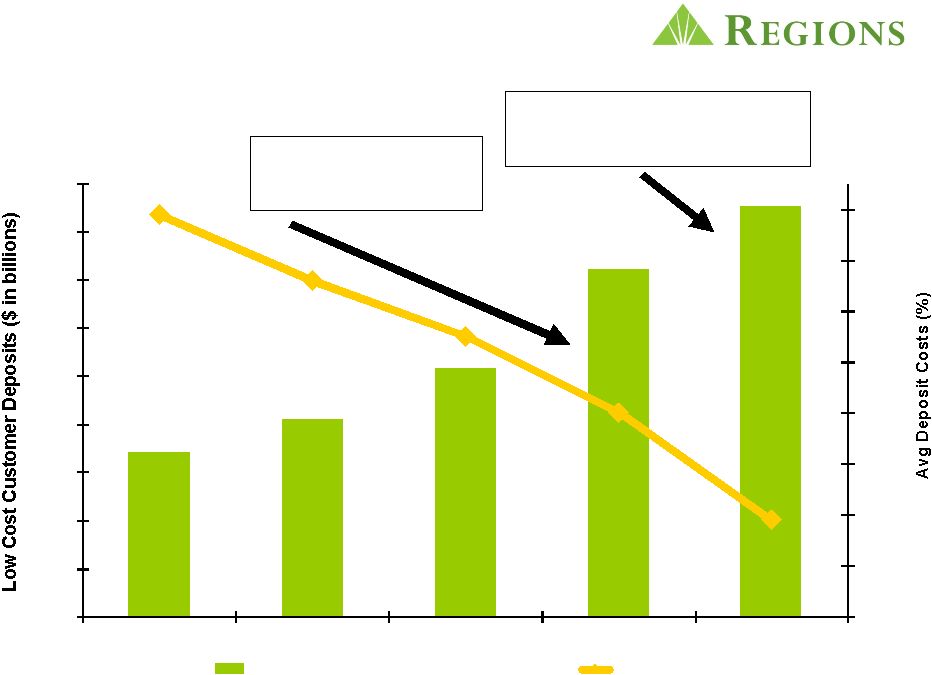 $60.9
$62.2
$64.3
$68.5
$71.1
0.6%
0.7%
0.8%
0.9%
1.0%
1.1%
1.2%
1.3%
1.4%
54.0
56.0
58.0
60.0
62.0
64.0
66.0
68.0
70.0
72.0
Q2 2009
Q3 2009
Q4 2009
Q1 2010
Q2 2010
Low Cost Customer Deposits
Deposit Costs
Strong Low Cost Deposit Growth
While Driving Lower Deposit Costs
June balances are 17%
higher than prior year
60 bps reduction
since 2Q09
139 bps
79 bps
5 |
 Peer
Bank Deposit Rate Analysis 1Q 2010 vs 2Q 2010
0.35%
0.50%
0.40%
0.76%
0.79%
1.17%
0.78%
0.90%
1.04%
0.54%
0.39%
0.29%
0.00%
0.20%
0.40%
0.60%
0.80%
1.00%
1.20%
1.40%
Wells
BofA
US
PNC
Comerica
M&T
SunTrust
5/3
Regions
BBT
M&I
Key
1Q
2Q
-0.02%
-0.07%
-0.08%
-0.08%
-0.03%
-0.05%
-0.21%
-0.05%
-0.05%
-0.15%
-0.04%
-0.02%
-0.30%
-0.20%
-0.10%
0.00%
Rate change from 1Q to 2Q
Regions Continues Improving Deposit Costs
Regions
6 |
 Improving Deposit Mix Driving Lower Deposit Costs
36% Time Deposits
27% Time Deposits
Q2 2009
Q2 2010
Reduced Time Deposit
Concentration by 25%
$95.0B
$98.1B
7 |
 Strong Year Over Year Checking
Account Growth
Exceeded Road to 1 Million Goal in 2009
On Target to Do It Again
488,200 Opened YTD
8 |
 Continue Rebalancing Profit Pools
›
Early Adopter –
moving away from Free Checking
›
Increased existing hurdle levels for LifeGreen Accounts
to be Free in 2Q 2010
›
Moving over 1.1 Million Free Accounts to LifeGreen in
3Q 2010
›
Product changes will not impact LifeGreen for Seniors
or Students
›
Completed launch of Relationship Rewards –
improving
customer loyalty and deepening wallet share
›
Launching Regions Cashback Rewards in August
9 |
 Regions Mortgage –
Expertise, Speed, Simplicity
and Exemplary Service Our Customers Count On
PORTFOLIO
SERVICING
PRODUCTION
CROSS-SELL
•
$15.6 Billion June 2010
Portfolio Yield 4.9%
•
$15.6 Billion June 2009
Portfolio Yield 5.5%
•
Forecasting $6.8 Billion in 2010
•
Second Best Retail
Production year
•
Record year in 2009,
$9.6 Billion of Production
•
Deposit Cross-sell penetration
>50% for Mortgage Only
Customers
•
Strong Title Insurance
penetration for Refi’s
•
$40 Billion in Servicing Balances
•
316,000 Loans
•
Foreclosure rates are less than
half the Industry Average*
* Mortgage Bankers Association of America Foreclosure Rate –
Q1, 2010
10 |
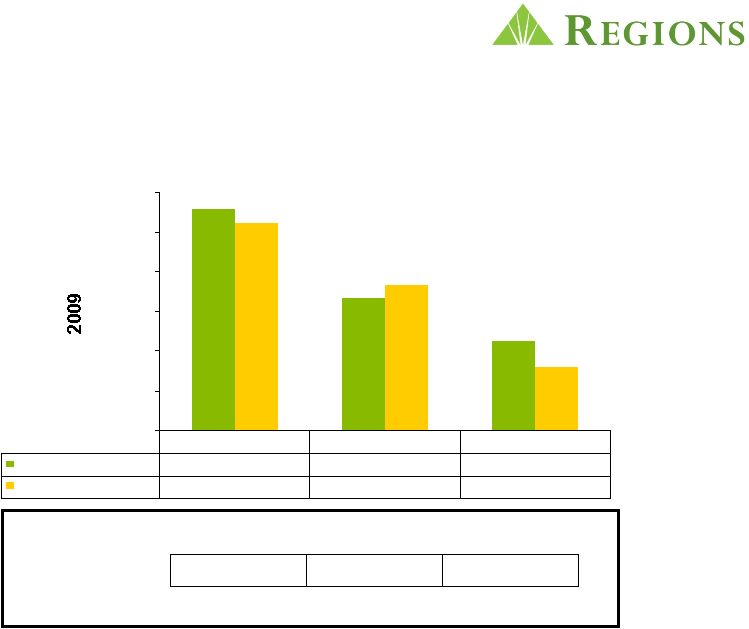 Regions Mortgage vs. Peer Group Average
Revenue per Loan
Cost per Loan
Income per Loan
Regions
$5,586
$3,331
$2,255
Peer Group Average
$5,248
$3,662
$1,586
$5,586
$3,331
$2,255
$5,248
$3,662
$1,586
$0
$1,000
$2,000
$3,000
$4,000
$5,000
$6,000
Highly Profitable Mortgage Production Unit
Market
Share*
–
Opportunity
to
Grow
In-Footprint
Regions
18
16
14
Profitability
Q3 2009
Q4 2009
*Q4 2009 National Market News Survey
Q3 2008
11 |
 Demand Remains Soft for Home Equity Lending
›
Demand will improve as
unemployment and
consumer confidence
improve
›
Current Book of Business is
80% Variable Rate
Portfolio Yield vs. Going-on Rate
Production
Q2 2009
Home Equity Balances
Q2 2010
14,802
15,796
16000
14000
Q2 2009
Q2 2010
350
330
346.6
339.2
12 |
 Targeting Growth in Consumer Lending
BRANCH SMALL BUSINESS
DIRECT TO CONSUMER LOANS
INDIRECT AUTO
UNDERSERVED CONSUMER
•
Targeting small businesses
between $250,000 and
$2 Million
•
Targeted industries
•
Targeted geographies
•
Re-entering Indirect Auto in
September
•
Cost efficient –
Low Risk
Business Model
•
Demand improving
•
Growing segment that is not
served well by Banks today
•
Developing Short Term Loan
products –
Targeting rollout
April 2011
•
Demand improving
•
Pre-approval at New Account
Opening to launch in 3Q2010
Growth
Growth
Growth
Growth
13 |
 In
Summary ›
Strong Core Deposit Growth Year Over Year
›
Improved Deposit Cost 60 Basis Points since 2Q2009 –
more to come
›
Focused on Rebalancing Profit Pools –
Deposit Mix
Changes, Free Checking, Relationship Rewards,
Cash Rewards
›
Focused on Prudent Loan Growth –
Mortgage, Direct,
Indirect Auto and Branch Small Business
›
Achieved Top 10% in Term of Customer Loyalty (Gallup)
14 |
 Business Services
John Asbury
*
*
*
* |
 We Are
Executing the Plan and Positioned for Growth
›
Managing risk
›
Diversification of revenue stream
›
Acquiring and expanding client relationships
›
Loan growth with pricing discipline
›
Low cost deposit gathering
›
Client satisfaction and loyalty
2 |
 We
Are Remixing our Loans Dec –
2013
Commercial
50%
Owner
Occupied
Real Estate
25%
Investor
Real Estate
25%
Commercial
40%
Owner
Occupied
Real Estate
24%
Investor
Real Estate
36%
Commercial
38%
Owner
Occupied
Real Estate
23%
Investor
Real Estate
39%
Jun –
2010
Dec –
2009
3 |
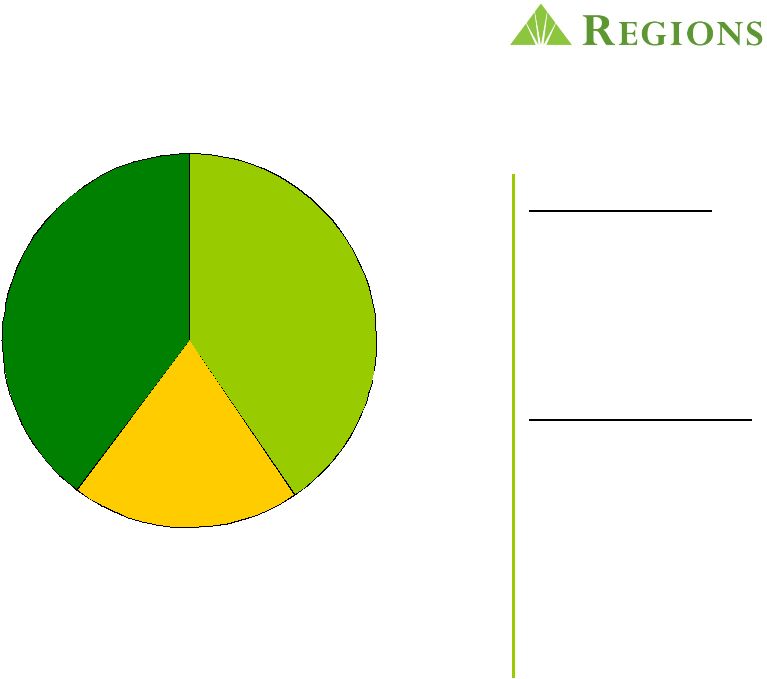 Revenue Is Well-Diversified by Line of Business
Product Groups
›
Treasury Management
›
Capital Markets /
Syndications
(Morgan Keegan)
›
Equipment Finance
Specialized Groups
›
Business Capital
(ABL)
›
Healthcare
›
Transportation
›
Public, Institutional,
Non-profit
›
Franchise Restaurant
Middle Market
›
C&I
›
Specialized
Groups
Commercial Real Estate
›
Professional income property
developers, owners and operators
›
Public real estate companies
›
Homebuilders
›
Affordable housing tax credits
Small Business
›
Business Banking
›
Community
Banking
›
Branch Small
Business
40%
20%
40%
4 |
 We
Have a Game Plan for Growing Loans ›
New client acquisition
›
Growing C&I Syndications with a lead and
relationship focus
›
Leverage specialty lending groups
›
Business Capital
›
Equipment Finance
›
Healthcare
›
Lending to targeted industries
›
Branch Small Business focus
›
Transportation
›
Franchise Restaurant
5 |
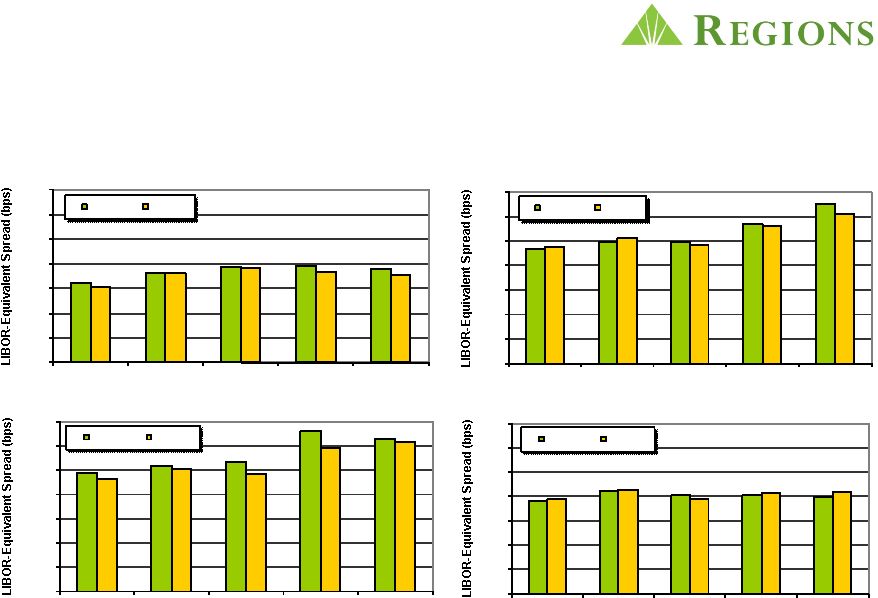 Loan
Pricing Compares Favorably to Market Data Source: Standard &
Poor’s Risk Adjusted New and Renewed Credit Spread Trends (excluding fees)
6
100
150
200
250
300
350
400
450
Q2 2009
Q3 2009
Q4 2009
Q1 2010
Q2 2010
LIBOR
-
C&I
Regions
Market
100
150
200
250
300
350
400
450
Q2 2009
Q3 2009
Q4 2009
Q1 2010
Q2 2010
LIBOR
-
Community Banking
Regions
Market
100
150
200
250
300
350
400
450
Q2 2009
Q3 2009
Q4 2009
Q1 2010
Q2 2010
LIBOR
-
Business Banking
Regions
Market
100
150
200
250
300
350
400
450
Q2 2009
Q3 2009
Q4 2009
Q1 2010
Q2 2010
LIBOR
-
CRE
Regions
Market |
 An
Intense Focus on Relationship Banking Results in Stable, Low-Cost
Deposits June 2010
61% of all deposits are checking
Interest
Checking
17%
Savings
1%
Money Market
excl Euro
26%
CDs
6%
Interest-Free
Checking
44%
Eurodollar
Sweeps
2%
Repo Sweeps
4%
7 |
 We
Have Continued to Reduce Interest Bearing Deposit Costs
2.55%
0.89%
0.60%
0.00%
0.50%
1.00%
1.50%
2.00%
2.50%
3.00%
1Q '08
2Q '09
2Q '10
8 |
 J.D.
Power Ranks Regions Small Business Customer Satisfaction Among Industry
Best Source:
J.D.
Power
and
Associates
2009
Small
Business
Banking
Satisfaction
Study
SM
9 |
 Regions Middle Market and Small Business
Stand Alone Among Major Banks in Our
Footprint by Growing Marketshare in 2009
“Regions is the only major provider in its segment to
capitalize on the opportunity and grow marketshare
during this challenging time.”
~ Greenwich & Associates
10 |
 Morgan Keegan & Company, Inc.
John Carson
*
* |
 Morgan
Keegan Business Model ›
Relationships, Expertise, Execution
›
“Glass-Steagall”
Model
›
Low Leverage
›
No Credit-Related Losses
›
No Proprietary Trading
›
Diversified Portfolio of Businesses
›
Key Activities
›
Investment Banking
›
Institutional Sales, Trading, and Research
›
Retail Brokerage
›
Personal and Corporate Trust
2 |
 Historical Performance
0%
5%
10%
15%
20%
25%
30%
0
200,000
400,000
600,000
800,000
1,000,000
1,200,000
1,400,000
1,600,000
2000
2001
2002
2003
2004
2005
2006
2007
2008
2009
Revenue
Operating Margin
3 |
 Business Units
›
Private Client Group
›
Fixed Income Capital Markets
›
Equity Capital Markets
›
Investment Banking
›
Regions Morgan Keegan Trust
›
Regions Capital Markets*
›
Regions Private Banking*
*New Divisions
4 |
 Legal
and Regulatory Environment ›
Fin Reg as currently defined: Minimal impact
›
No prop trading
›
Fiduciary standard?
›
RMK and a “Tale of Two Cities”
›
Regulatory actions
5 |
 Strategies and Opportunities
›
Business Model Works!
›
Low Cost
›
Low Risk
›
Steady Growth
1.Maximize
profitability from Fixed Income and Trust
2.Capitalize
on Retail Wealth Management opportunities
3.Leverage
Industry Expertise to build a Universal Bank to the Middle
Markets ›
Healthcare
›
Energy
›
Public Finance
›
Real Estate
›
Transportation
6 |
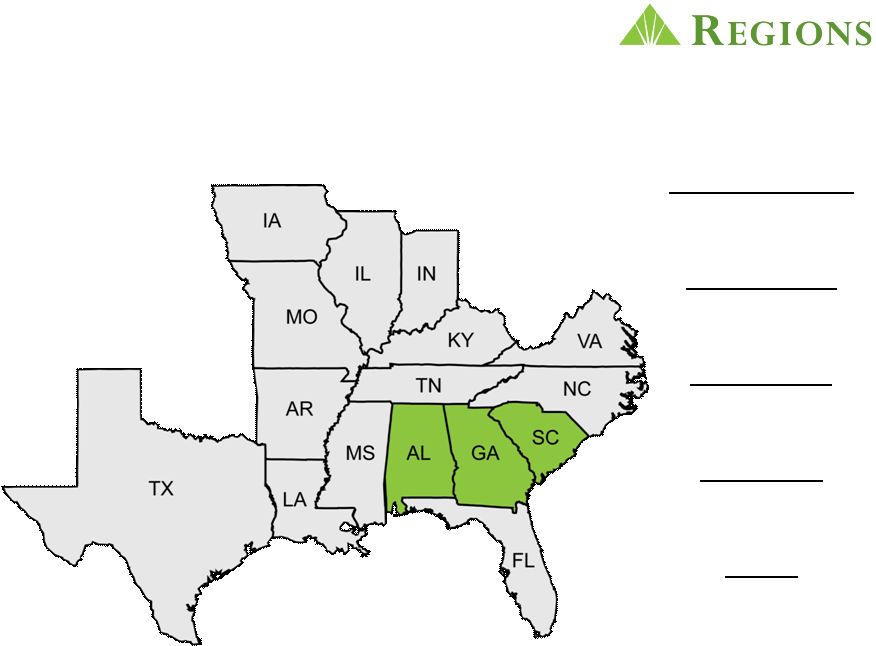 Geography Review: Bill Ritter
Total Deposits
$24.0B
Total Loans
$17.6B
Associates
4,017
Branches
422
ATMs
519
1 |
 Market Composition
Industry Drivers
›
Manufacturing
›
Healthcare –
Specialty and Research
›
Aerospace/Defense
Economic Stats
›
High Population Growth –
Young, educated workers in
Atlanta and military/civilian in Huntsville
›
Low costs of living and of doing business
2
Dominant Market Share in Alabama
Growth Opportunity in Atlanta |
 Opportunities
Accelerate growth in our Atlanta Market
›
Upgraded talent in all Lines of Business
›
Increase Market Penetration –
Branches and ATMs
Capitalize on Market Disruption
›
Bank Mergers: Wells/Wachovia and BB&T/Colonial
›
Bank Failures: 44 in 2009 and 2010
Develop Government Contracting Business
›
Full banking relationship with privately held defense contractor
Continue to Leverage Partnerships
›
Regions Morgan Keegan Trust
›
Regions Business Capital
3 |
 Geography Review: Brett Couch
Total Deposits
$18.8B
Total Loans
$16.2B
Associates
3,121
Branches
397
ATMs
440
1 |
 Market Composition
Industry Drivers
›
Professional / Business Services
›
Education
›
Healthcare
›
Retail Trade
›
Leisure/Hospitality
Economic Stats
›
11.7% unemployment rate is 5th highest in the country, down last
two months
›
Home values down 46% from the 2006 peak, flat four consecutive months
›
20th largest economy in the world
›
21 commercial airports, 14 deep water sea ports, proposed high speed rail
2
Migration of consumers and businesses to Florida (climate, low taxes)
RF 4.4% market share and 7.4% outlet share…growth opportunity
|
 Opportunities
Accelerate Small Business Growth
›
1.6 million in Florida…
4th in country
›
Stability, expertise, and personal service
›
Emphasis in branches
Increase Consumer Market Share
›
Population of 18 million…
4th in country
›
Market deposits…
$400 billion
›
Market share opportunity
Leverage Morgan Keegan Partnership
›
592,000 HHs with $500M+ investable assets
3 |
 Geography Review: Keith Herron
Total Deposits
$26.9B
Total Loans
$17.1B
Associates
4,239
Branches
514
ATMs
684
1 |
 Market Composition
Industry Drivers
›
Healthcare
›
Agriculture
›
Transportation
›
Manufacturing
Economic Stats
›
Home to 78 Fortune 500 Companies
›
Relocations and Expansions remain steady
2
#1 Market Share in Tennessee
Dominant Nashville Bank –
“City on the Move”
Midsouth
footprint brings economic diversity to Regions |
 Opportunities
Accelerate Growth in Midwest Markets
›
St. Louis (Gateway Initiative) and Indianapolis (Indy Initiative)
›
Expand agricultural banking into markets with Regions presence
Healthcare
›
Nashville is home to over 20 publically traded healthcare companies
›
Capture Nashville healthcare market share
›
Build out healthcare throughout the Midsouth
Deepen Existing Relationships
›
Morgan Keegan partnership
›
Tennessee cross-sell
3 |
 Geography Review: Ronnie Smith
Total Deposits
$21.4B
Total Loans
$12.4B
Associates
3,565
Branches
441
ATMs
518
1 |
 Market Composition
Industry Drivers
›
Water Ports / Waterways
›
Petro Chemical
›
Energy / Oil and Gas
Economic Stats
›
Ten Metro Markets across Footprint
›
Home to 70 Fortune 500 Companies
›
Unemployment below National Average
›
Agriculture
›
Healthcare
2
Natural Resource Focus |
 Opportunities
Leverage Top 3 Market Share in Mississippi, Arkansas and Louisiana
›
75% of revenue growth in these markets comes from existing client base
›
Stronger focus on Business to Business selling through established
branch network
Growth Market in Texas
›
Attacking market through strategic acquisition of Business Services teams
focused in Dallas, Houston and Austin
Natural Resource Focus
›
Waterways, Agriculture and Oil and Gas
›
Leverage proven industry expertise throughout the region
Leverage Strategic Partnerships Throughout Region
›
Morgan Keegan
›
Regions Mortgage
›
Regions Insurance
›
Specialty Lending
3 |
 Appendix
*
*
*
* |
 Appendix
–
Non-GAAP Financial Measures
Note: The following tables in the next two slides illustrate the
method of calculating the non-GAAP
financial measures used in this slide presentation:
2
Q2
Q3
Q4
Q1
Q2
($ in millions)
2009
2009
2009
2010
2010
Net Interest Income (GAAP)
$ 831
$ 845
$ 850
$ 831
$ 856
Non-Interest Income (GAAP)
1,199
772
718
812
756
Less Adjustments:
Securities gains (losses), net
108
4
(96)
59
Gain on sale of Visa shares
80
-
-
-
-
Leveraged lease termination gains
189
4
71
19
-
Gain on early extinguishment of debt
61
-
-
-
-
Core Non-Interest Income (non-GAAP)
761
764
743
734
756
Core Revenue (non-GAAP)
1,592
1,609
1,593
1,565
1,612
Non-Interest Expense (GAAP)
1,231
1,243
1,219
1,230
1,326
Less Adjustments:
Loss on early extinguishment of debt
-
-
-
53
-
FDIC special assessment
64
-
-
-
-
Securities impairment, net
69
3
-
1
-
Branch consolidation costs
-
41
12
8
-
Regulatory charge
-
-
-
-
200
Core Non-Interest Expense (non-GAAP)
1,098
1,199
1,207
1,168
1,126
Core Pre-Tax Pre-Provision Net Revenue (non-GAAP)
494
410
386
397
486 |
 Appendix –
Non-GAAP Financial Measures
3
Q2
Q3
Q4
Q1
Q2
($ amounts in millions, except per share data)
2009
2009
2009
2010
2010
Net income (loss) available to common shareholders (GAAP)
(244)
(437)
(606)
(255)
(335)
Adjusted Items, Net of Tax
(65)
25
(55)
2
200
Net income (loss) available to common shareholders, excluding
adjusted items (non-GAAP)
(309)
(412)
(551)
(253)
(135)
Weighted-average diluted shares
876
1,189
1,191
1,194
1,200
Earnings (loss) per common share -
diluted (GAAP)
$ (0.28)
$ (0.37)
$ (0.51)
$ (0.21)
$ (0.28)
Earnings (loss) per common share, excluding adjustments -
diluted (non-GAAP)
$ (0.35)
$ (0.35)
$ (0.46)
$ (0.21)
$ (0.11) |
